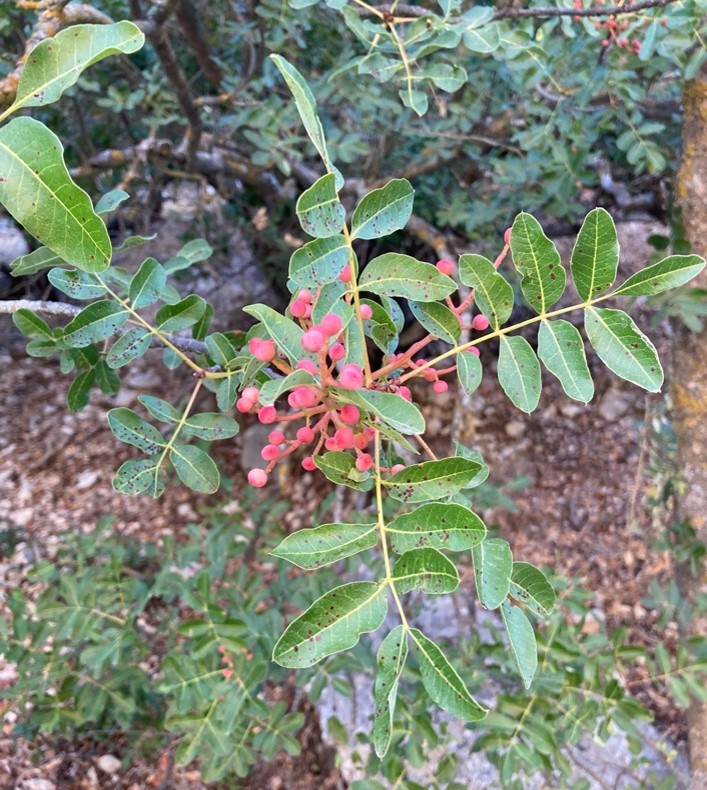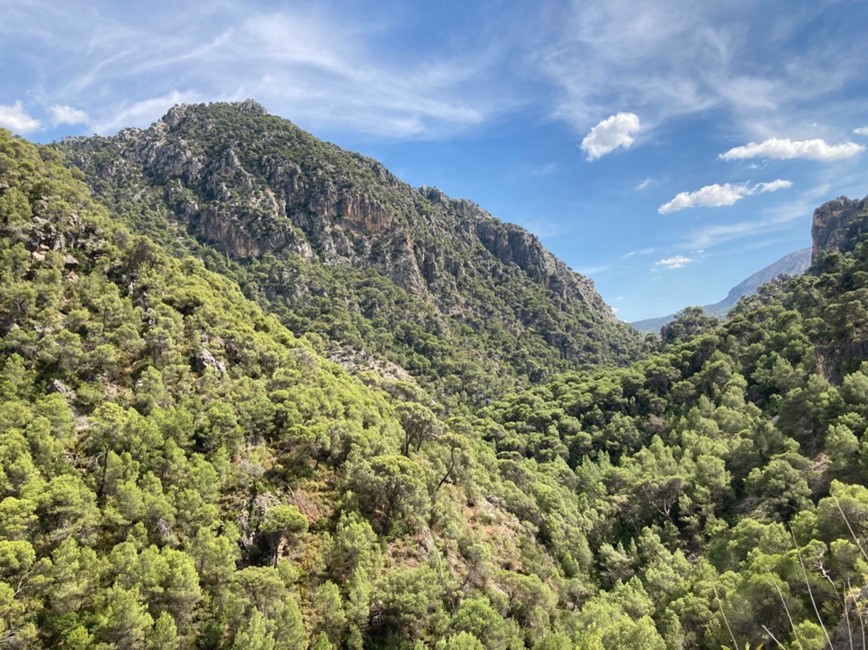

The interest on the microbial ecosystems that inhabit leaves is rapidly increasing due to their participation in basic ecosystem functions. One of the aspects of plant dynamics which leaf fungi can most clearly affect is recruitment, since the success of newly germinated plants can be seriously compromised by pathogenic activity or by the absence of saprotrophs and mutualists. The development of multisequence techniques have allowed the exploration of fungal microbiomes of wild plant species in the field. In our study we seek to disentangle the effect of phyllosphere pathogenic, saprotrophic and epiphytic fungi in the assembly of the sapling bank in forest communities during recruitment, providing information about the potential influence of each fungal guild on vegetation dynamics.


Some examples of leaf-inhabiting pathogenic fungi in Crataegus monogyna and Pistacia terebinthus, two of our studied species. C. monogyna is attacked by the pathogen Gimnosporangium sp., a rust fungus with an heteroecious life-cycle that alternates between Juniperus species and different species in Rosaceae. P. terebinthus is infected by Pileolaria terebinthi, fungal pathogen specialized in this plant species that causes necrosis in the leaves, accelerating their fall.
Our study sites are the mixed pine-oak Mediterranean forests of Sierra de Jaén and Sierra de Segura, located in the southern Iberian Peninsula in Spain. We studied 38 woody and shrub plant species that characterize both forests; Check out the map below and the amazing Mediterranean landscape of both locations!



Our two study sites: Sierra de Jaén (1) and Sierra de Segura (2). Jaén is dominated by mixed forests of Pinus halepensis, Quercus ilex and Quercus faginea, while Segura is characterized by forests of Pinus nigra subsp. salzmanii, Quercus faginea and Quercus pyrenaica. Both forests count with an enriched canopy of small trees and tall shrubs composed by the genera Acer, Crataegus, Juniperus, Pistacia, Sorbus, Prunus and Phillyrea, and an understory of small shrubs of the genera Cistus, Genista, Phlomis, Rosmarinus and Thymus.
To determine the effect of leaf-inhabiting fungi on plant recruitment, we combined information on the frequency of canopy-recruit interactions (published in Alcántara et al. 2019b) and phyllosphere fungal communities (published in Pajares-Murgó et al. 2023). Briefly, the phyllosphere fungal communities of our studied species were characterized using DNA sequencing techniques in order to identify fungal OTUs and classify them into functional guilds using the FungalTraits database (Põlme et al. 2020). In parallel, we obtained the abundance of the studied plant species in the field by quantifying their canopy cover, and estimated the frequency of canopy-recruit interactions by counting the number of saplings (recruits) of each species growing underneath each canopy species.
One interesting aspect of our research is based on the properties of the recruitment matrix assembled from the frequency or the probability of recruitment of each species under each other: the recruitment frequency matrix gives us information on the structure of the sapling bank and the canopy contribution to the sapling bank, and the binary matrix obtained from probability of recruitment (the presence or absence of recruitment of species i underneath canopies of species j) allows to define the recruitment niche of a species or the canopy service provided by canopy species. Therefore, we divided our analyses in two levels: the pairwise-level analysis explored how the dissimilarity of each fungal guild between pairs of plant species influences the probability and frequency of recruitment of one species under the other; the species-level analysis explored whether the richness and the diversity of each fungal guild associated with each plant species affects different aspects of recruitment.

Our results provide the first evidence of the effect of different guilds of phyllosphere fungi on plant recruitment at community-level in the wild. Beyond the well-known role of pathogenic fungi on negative density-dependent mortality, our results show the mutualistic effect of fungal epiphytes and a dual role of saprotrophs as antagonistic, decreasing recruitment of certain species, or mutualistic, enhancing recruitment in the sapling bank.
Studying the role of phyllosphere fungi in ecosystem functions of natural communities can be useful to better understand how functionally diverse plant-associated microbiomes influence vegetation dynamics, and evaluate their potential for the conservation of plant communities in the wild. But first, we need to know if those relationships are widespread across biogeographic regions and ecosystems, so we are on it!



Our field work: we collect data on the frequency of canopy-recruit interactions by stablishing plots of 50 x 50 m where we first register the abundance of canopy species as the total canopy cover (canopy projection in m2). Second, we estimate the frequency of canopy-recruit interactions by performing a systematic search of saplings of all woody species throughout the plot, and registering their identity and abundance, and the canopy species identity where they are growing beneath. Right now, we are conducting samplings in different ecosystems across Andalucía (upper right picture in Quercus suber forest in Cadiz, lower picture in Cabo de Gata, Almería, and left picture in Sierra de las Nieves, Málaga).
Follow Mariona @marionapajares and check out the full piece at: https://besjournals.onlinelibrary.wiley.com/doi/10.1111/1365-2745.14311?af=R
References:
Alcántara, J.M., Garrido, J.L. & Rey, P.J. (2019b). Plant species abundance and phylogeny explain the structure of recruitment networks. New Phytologist.,223, 366–376.
Pajares‐Murgó, M., Garrido, J.L., Perea, A.J., López‐García, Á. & Alcántara, J.M. (2023). Biotic filters driving the differentiation of decomposer, epiphytic and pathogenic phyllosphere fungi across plant species. Oikos, 2023, e09624.
Põlme, S., Abarenkov, K., Henrik Nilsson, R., Lindahl, B.D., Clemmensen, K.E., Kauserud, H., et al. (2020). FungalTraits: a user-friendly traits database of fungi and fungus-like stramenopiles. Fungal Diversity, 105, 1–16.



